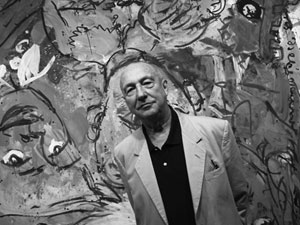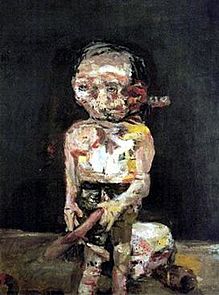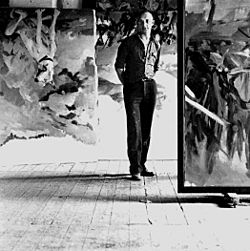Georg Baselitz facts for kids
Quick facts for kids
Georg Baselitz
|
|
|---|---|

Georg Baselitz in a photograph by Oliver Mark
|
|
| Born | 23 January 1938 Deutschbaselitz, Germany
|
| Nationality | German, Austrian |
| Known for | Painting, sculpture, graphic design |
| Movement | Neo-expressionism |
| Spouse(s) | Johanna Elke Kretzschmar |
Georg Baselitz (born January 23, 1938) is a famous German painter, sculptor, and graphic artist. He is best known for his expressive, figurative paintings. Figurative art is art that clearly represents something from the real world, like a person or an object.
In 1969, Baselitz started painting his subjects upside down. He did this to make people focus on the colors and shapes of the painting itself, rather than just what the painting was showing. This unique style made him famous around the world. His art is influenced by many things, including Soviet-era art, Mannerist art, and African sculptures.
Baselitz was born as Hans-Georg Kern in a village called Deutschbaselitz in Germany. He grew up during World War II, and seeing so much destruction had a big impact on his life and art. He once said, "I was born into a destroyed order, a destroyed landscape, a destroyed people, a destroyed society. And I didn't want to reestablish an order... I was forced to question everything... to start again." This idea of breaking rules and starting fresh is a key theme in his work.
Contents
Life and Career
Early Life and Education
Baselitz was born in what would later become East Germany. His father was a school teacher, and their family lived in the school building. As a boy, he saw a painting in his school's assembly hall that inspired him. By the time he was 15, he was already painting portraits, still lifes, and landscapes.
In 1956, he began studying art at a university in East Berlin. However, he was asked to leave after only two semesters. The school said he had "sociopolitical immaturity," which meant he wasn't following the strict artistic rules of the socialist government.
A year later, he moved to West Berlin and continued his art studies at the Hochschule der Künste. There, he learned about different styles of modern art and became friends with other artists. In 1961, he changed his name from Hans-Georg Kern to Georg Baselitz, in honor of his hometown.
Personal Life
In 1962, Baselitz married Johanna Elke Kretzschmar. They have two sons, Daniel and Anton, who both work as art gallery owners. Since 2013, Georg and his wife have lived in Salzburg, Austria, and they became Austrian citizens in 2015.
Artistic Work
Early Work and Controversy
In the early 1960s, Baselitz began to develop his own unique style. His first solo art show in West Berlin in 1963 caused a big stir. Two of his paintings were considered shocking and controversial by the public. The authorities seized the paintings, and it took a two-year court case before they were returned. This event made the young artist famous.
After this, Baselitz began making etchings and other kinds of printmaking. He also spent time in Florence, Italy, where he studied the art of the Mannerist period.
The Heroes and Fracture Paintings
Between 1965 and 1966, Baselitz painted a series of works called Heroes (Helden). These paintings show large, worn-out figures in empty landscapes. The figures often look broken or defeated. They were meant to be a comment on the false ideals of Germany's past.
After the Heroes, he created a group of pictures called Fracture Pictures (Frakturbilder). These paintings looked like they were split or broken apart.
Why Does Baselitz Paint Upside Down?
In 1969, Baselitz painted his first picture with an upside-down subject, called The Wood on Its Head. By turning his subjects upside down, Baselitz forces the viewer to see the painting in a new way. Instead of focusing on the person or object in the picture, you pay more attention to the colors, textures, and lines.
This became his signature style. He wanted to show that a painting is an object in its own right, not just a picture of something else.
Later Career
Throughout the 1970s, Baselitz continued to explore his upside-down style, often painting landscapes. He also began using his fingers to paint. He took part in major art shows, like documenta 5 in Kassel, Germany.
In the 1980s, he started making large wooden sculptures. He also became a professor at art academies in Karlsruhe and Berlin. His work was shown in New York for the first time, and he received many awards for his art.
In the 1990s, major museums around the world, including the Guggenheim in New York, held large exhibitions of his work. He also designed a stamp for the French postal service.
Recent Work
Baselitz is still an active artist. In recent years, he has painted a series of portraits of himself and his wife, Elke. These paintings use dark colors and explore themes of aging and memory.
For his 80th birthday in 2018, several major museums in Europe and the United States held special exhibitions to honor his long career. He continues to have his work shown in galleries and museums all over the world.
Art Market
Georg Baselitz is one of the most successful living artists. His paintings and sculptures sell for millions of dollars at auctions.
- His most expensive painting, Mit Roter Fahne (With Red Flag), sold for over £7.4 million in 2017.
- His most expensive sculpture, Dresdner Frauen – Besuch aus Prag (Women of Dresden – Visit from Prague), sold for over $11.2 million in 2022.
Honours and Awards
Baselitz has received many awards throughout his career. Some of the most important ones include:
- 1986: Goslarer Kaiserring, a prestigious German art prize
- 1999: Honorary member of the Royal Academy of Arts in London
- 2004: Praemium Imperiale, a global arts prize from Japan
- 2005: Austrian Decoration for Science and Art
- 2012: Chevalier de la Légion d'Honneur, a high honor from France
Works
See List of works by Georg Baselitz
See also
 In Spanish: Georg Baselitz para niños
In Spanish: Georg Baselitz para niños
- List of German painters



